#Museo Hermitage
Explore tagged Tumblr posts
Text
Museums
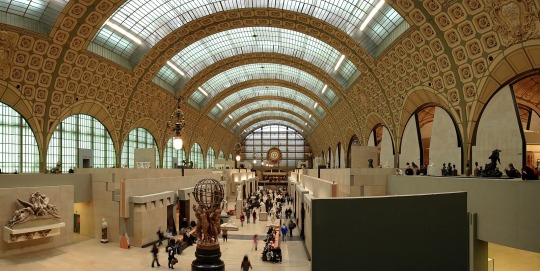
Source: Benh (2007), Main Alley Of The Musee d‘Orsay, Wikipedia, CC BY-SA 3.0 https://en.m.wikipedia.org/wiki/File:MuseeOrsay_20070324.jpg

Source: Musee d‘Orsay, Self-portrait, Vincent van Gogh, 1889, Public Domain

Source: Munch Museum, The Scream, Edvard Munch, 1893-1910, Public Domain
Travel guides usually list a variety of museums for each place that you can or even should visit - if you want to know where we come from, what is important to us or what defines us or has defined us at some point. I also strolled through one or the other museum because I saw it as part of my education. I just wanted to know and understand. It often took me to art museums - although I didn't have any real access to this "kind of art“ at the time (music, literature and movies rather touched my soul). And nowadays architecture and sculptures fascinate me even more than painting…as well of course landscapes: there is probably no more creative artist than nature itself. When visiting an art museum, it soon became customary for me to buy a museum guide to leaf through at home from time to time. There are a few museums that have stuck in my mind or that I simply like:
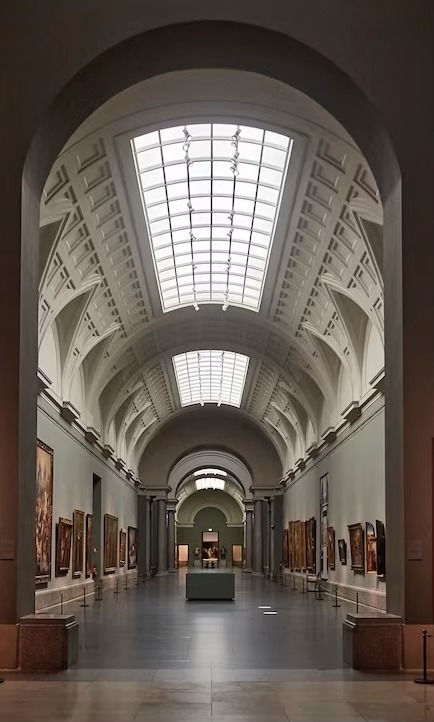
Museo Del Prado
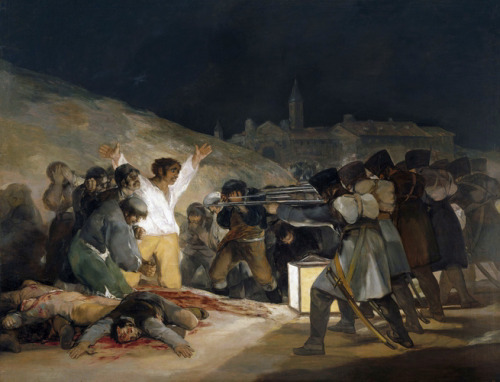
Source: Museo Del Prado, The Third of May 1808 in Madrid, Francisco de Goya, 1814, Public Domain
Musee d'Orsay (Paris): Accommodated in a beautiful old train station building, the museum contains an extensive collection of French Impressionists. Actually a "must" for everyone who likes this art epoch.
Munch Museum (the former museum in the Toyen district of Oslo): was a small, cute museum entirely devoted to the work of Edvard Munch. I was particularly impressed by the small presentation of pieces from his life - especially his first pictures from early childhood. If children of this age are still drawing stick figures, he has already drawn in perspective. So his talent showed quite early. Painters often seem to perceive the world differently than ordinary people. There is a similar presentation about van Gogh in the Van Gogh Museum in Amsterdam.
Prado (Madrid): My former school once disposed old school books - including old history books. These contained many beautiful illustrations and contemporary paintings - almost art books. I particularly liked leafing through the book about the Napoleonic Wars - because of my penchant for Napoleon. It also contained a painting by Francisco de Goya: "The Third of May 1808 in Madrid". Maybe why I often got stuck on it, because it reminded me of a scene from "War and Peace" (by Tolstoy): the shooting of alleged arsonists in Moscow. The cruelty of war: you die because you just took a wrong turn at the corner. That's why I wanted to go to the Prado in Madrid - to see this painting.
Hermitage (St. Petersburg): The museum is accommdated in the Winter Palace of the Romanovs. The building itself is a feast for the eyes - and of course the unmeasurable art treasures inside of it. We were particularly fascinated by the oversized vases made entirely of mosaics - something we had never seen before.
Roman Forum (Rome): Rome itself is actually an open-air museum - but the Roman Forum reinforces this impression. Many know the history of Rome from class, books (e.g. Colleen McCullough's series on the last years of the Roman Republic) or movies. You stroll through the streets, squares and gardens and regularly meet "old friends". You can really feel the importance and history of the place.
National Maritime Museum (London): The museum is the largest museum of maritime history in the world - a dream for anyone who is interested in that. Models of historical ships enough.
USS Constitution (Boston): A 19th-century US Navy frigate (sailing ship) - still "in service" although now only serving as a museum ship. The crew tells visitors the history of the ship in a lively and funny way, making a visit a fun affair.
Natural History Museum (London): The museum is one of the largest natural history museums in the world and is also located in a beautiful Romanesque-Byzantine building. When I visited the museum, there was a special exhibition on Charles Darwin. You could immerse in Darwin's world of ideas through carrying out experiments and by that understand his findings. This made science tangible. Incidentally, the Technical Museum in Munich follows the same approach: you understand physical phenomena by carrying out experiments (e.g. the behavior of waves at fixed or open ends).
Kennedy Space Center (Cape Canaveral): old rockets, space capsules, launch pads - a look into the history of the US space program and the preparation of current space projects. So much positive energy and enthusiasm for science and engineering. I was lucky that I was able to witness the launch of a space shuttle during my stay there (Space Shuttle Atlantis, Mission STS-86 to the Mir Space Station). A goosebump moment.

Hermitage
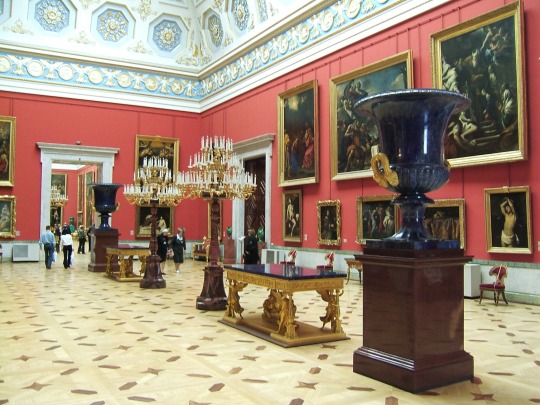
Hemitage: Oversized Vases
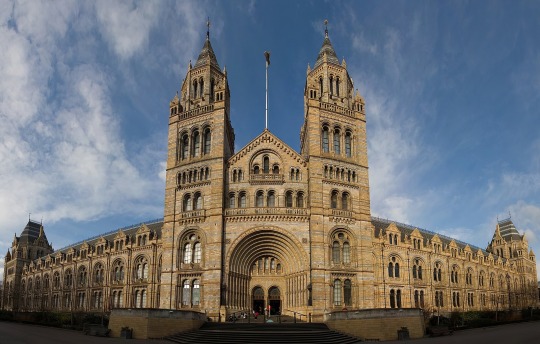
Source: Iliff, David (2006), The Natural History Museum, Wikipedia, CC BY-SA 3.0 https://en.m.wikipedia.org/wiki/File:Natural_History_Museum_London_Jan_2006.jpg

Kennedy Space Center - Launch Pad

Launch of Space Shuttle Atlantis STS-86
-Simplicius Simplicissimus
#traveling#museums#musee d’orsay#munch museum#museo del prado#hermitage#eremitage#forum romanum#national maritime museum#uss constitution#natural history museum#kennedy space center#cape canaveral#art#simplicius simplicissimus
0 notes
Text

Christ Carrying the Cross
Artist: Sebastiano del Piombo (Italian, 1485-1547)
Date: 1515–1517
Medium: Oil on panel
Collection: Art Institute of Chicago, Chicago, IL, United States
Description
Here, Simon of Cyrene assists Jesus, emphasizing the heavy weight of the cross on his shoulders. A Roman soldier stands behind, his jeering face just visible in the darkness. In the background, the tightly packed composition opens up onto a crowd assembling at the foot of the hill of Golgotha, with two crosses barely visible. The luminous landscape is a hallmark of the artist's Venetian training. The painting's dramatic visual impact is a result of the powerful diagonals of the cross; the dynamic, almost sculptural quality of Christ's clothing; and the pathos of his expression.
The Art Institute's version is an autograph replica of a painting—now in the Museo del Prado, Madrid—made for Jerónimo Vich y Valterra, the Spanish ambassador to Rome. Other versions survive in the State Hermitage Museum, Saint Petersburg; the Monasterio de las Descalzas Reales, Madrid; and the Szépmüvészeti Múzeum, Budapest.
#painting#oil on panel#stations of the cross#christianity#jesus#roman soldier#cross#golgotha#simon of cyrene#biblical art#16th century painting#sebastiano del piombo#italian painter#new testament#holy bible#christian art
29 notes
·
View notes
Text

Two Angels and a Holy Archbishop, Hermitage of Vera Cruz, Maderuelo (Segovia). 11th-12th Century CE.
Museo National Del Prado.
#museo national del prado#prado#Spain#spanish history#medieval history#medieval#art#culture#history#museum#segovia
15 notes
·
View notes
Text
Estatua romana de mármol de Dioniso (Baco), el Dios del vino, patrono del proceso de producción del vino.
Copia romana de un original griego del final del siglo IV adC.
Museo del Ermitage, San Petersburgo.
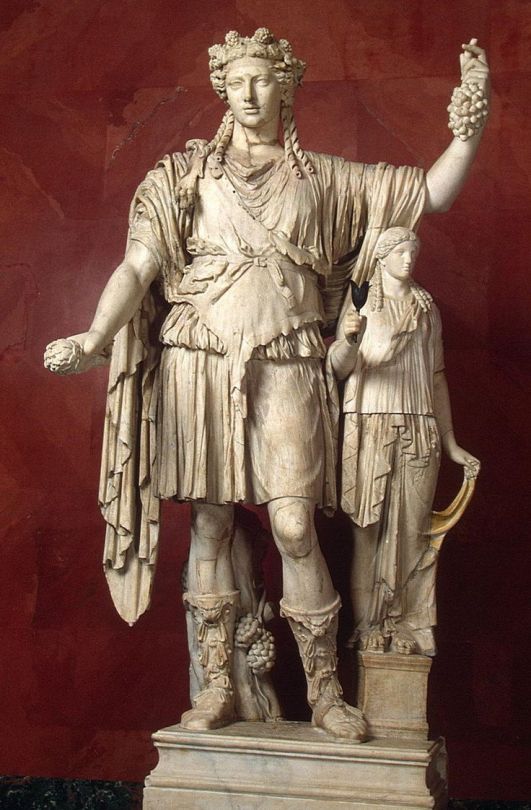
Roman marble statue of Dionysus (Bacchus), God of wine, patron of wine making.
Roman copy of a Greek original of late 4th century BC.
from The Collection of The Hermitage, St Petersburg
683 notes
·
View notes
Text






Pietro Tenerani (1789 - 1869) - uno de los escultores italianos más famosos de la segunda mitad del siglo XIX. Estudió en la famosa Academia de Bellas Artes de Carrara. Sus maestros fueron los destacados maestros Canova y Thorvaldsen, bajo cuyo liderazgo Tenerani logró un éxito extraordinario en el procesamiento del mármol. Fue presidente de la Academia de San Lucas, de los Museos Capitolinos y director de los Museos Vaticanos. En 1838, el heredero al trono ruso, el gran duque Alejandro Nikolaevich, visitó el taller tenerani en Roma. Admirado por el modelo de "Flora", mandó ejecutarlo en mármol, y se encuentra en el Hermitage, al igual que "Venus y Cupido".
69 notes
·
View notes
Text
Emil Wolff - 1832 - Achile - Museo Dell 'Hermitage San Pietroburgo

76 notes
·
View notes
Text
More images of 1913 fashion -
1913 Ethel Mary, née Bell-Irving, later 15th Countess of Lauderdale by Samuel Henry William Llewellyn (Thirlestane Castle - Lauder, Berwickshire, UK) From centuriespast.tumblr.com/post/148847411164/ethel-mary-18911970-15th-countess-of 815X1200.

Left 1913 Gazette du Bon Ton "Le Conseiller des Dames Robe et Manteau pour le Theatre" by Barbier 643X844.
Right 1913 Gazette du Bon Ton "Tais-Toi Mon Coeur!… Robe de lingerie de Doeuillet 1913 Gazette du Bon Ton "Le Marriage au Chateau" by Brissaud artophile.com 750X1011.

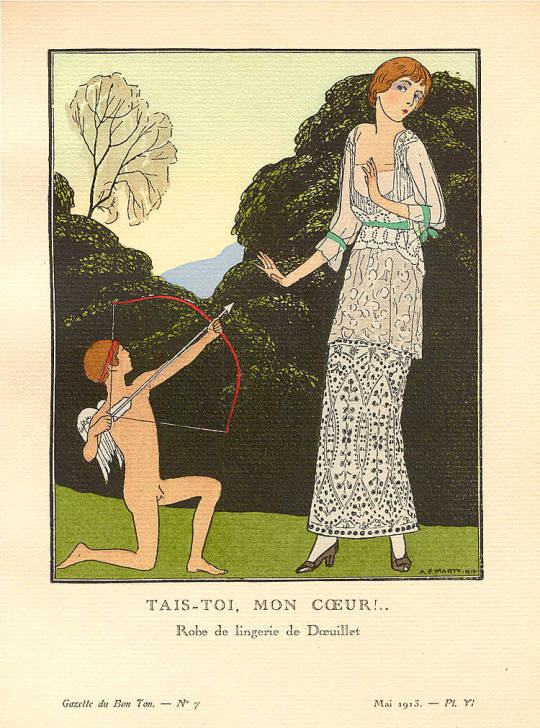
1913 Gazette du Bon Ton "Le Marriage au Chateau" by Brissaud. From artophile.com 1797X1125.
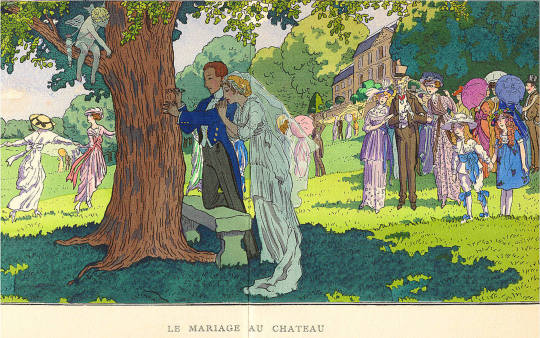
Left 1913 Journal des Dames et des Modes "Manteau de velours frappe citron. Col velours blance et Renard blanc" by Dammy. From artophile.com 750X1189.
Center 1913 Journal des Dames et des Modes "Mantelet de taffetas a la vieille garni de chenille verte - Manchon brode de perles". From artophile.com 757X1200.
Right 1913 Journal des Dames et des Modes "Parure d'Hermine et Putois". From artophile.com 701X1200.
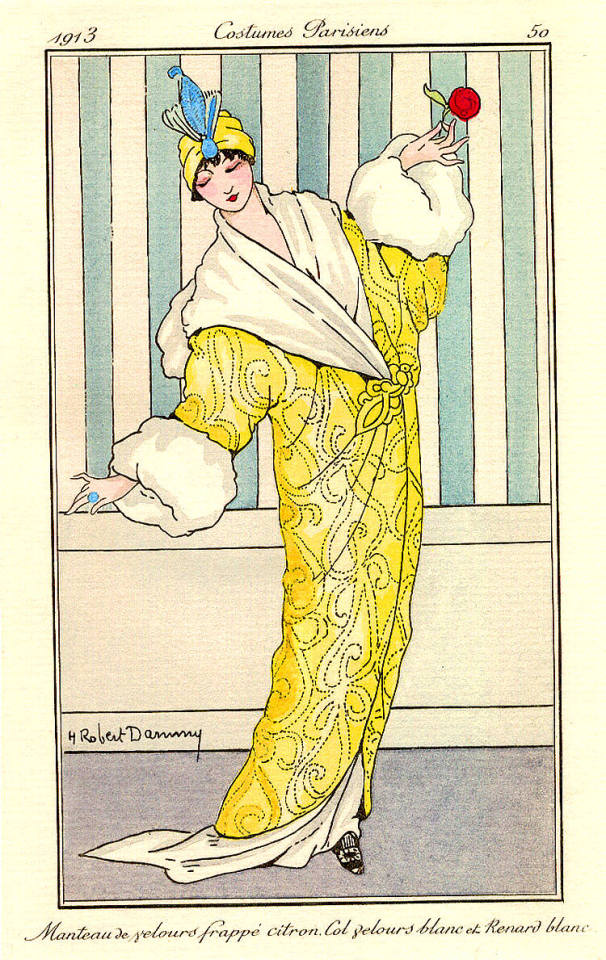

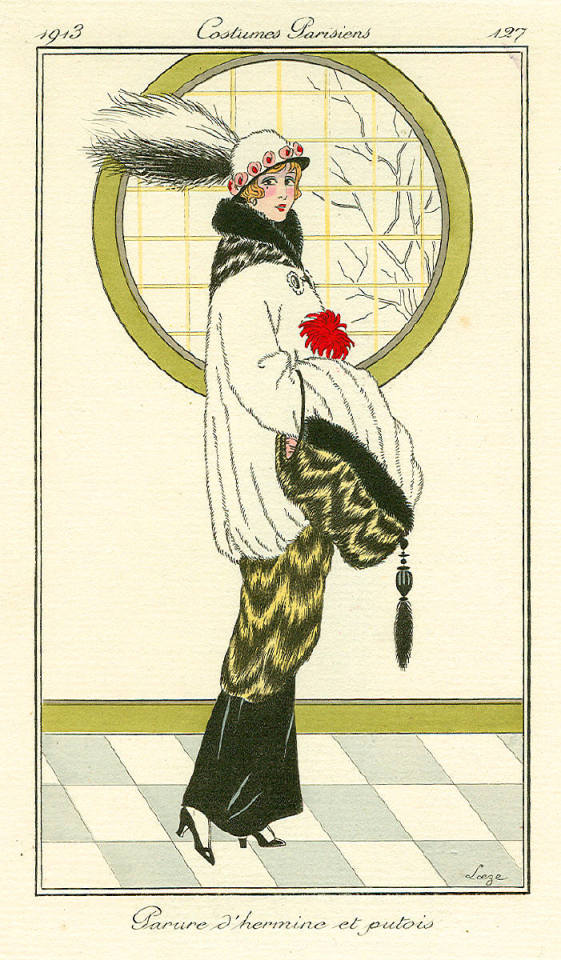
1913 Lady, traditionally identified as Rosa Lewis by Frank Moss Bennett (auctioned by Christie's). From their Web site 906X1904.

Left 1913 Journal des Dames et des Modes "Robe de charmeuse blance a tunique de mousseline de soie violette brodee de perl et bordee de skunks. Manteau de velours etrusque" by Pichenot artophile.com 750X1197.
Right 1913 Journal des Dames et des Modes "Robe de charmeuse nore avec corsage et panier formes d'un obi drape" by Barbier artophile.com 734X1200.

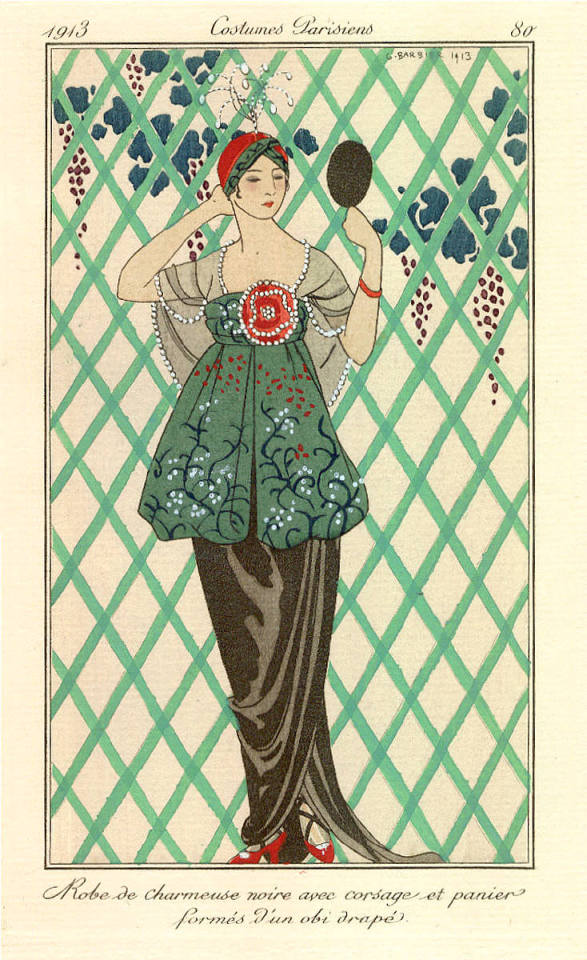
1913 Madame Jean Maillard-Norbert by Léon François Comerre (location ?). From tumblr.com/eirene; fixed most obvious spots w Pshop 1332X3072.

1913 Lina Bilitis with Two Pekinese by Giovanni Boldini (location ?). From Amber Tree's photostream on flickr 1510X2872.

1913 Madame Michelham by Giovanni Boldini (location ?). From wikiart.org-en-giovanni-boldini-madame-michelham-1913 1589X2356 @72.
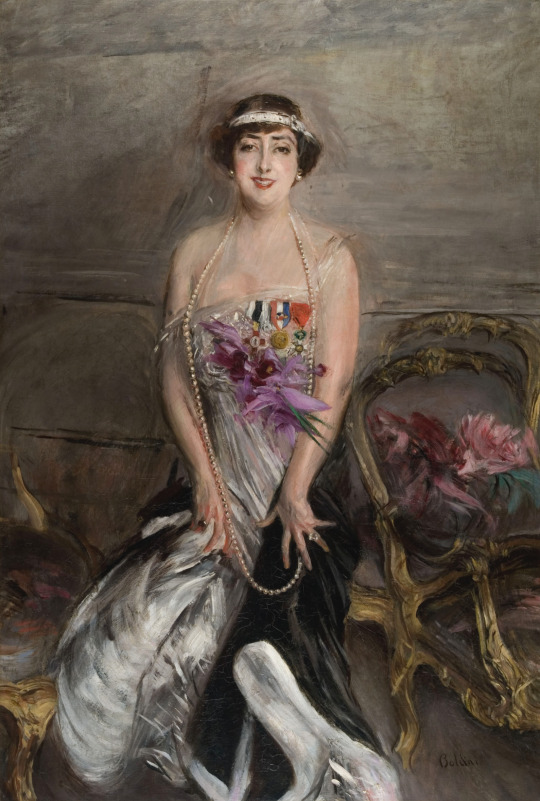
1913 María Teresa González del Valle by Nicanor Piñole (Fundación Banco Santander - Madrid, Spain). From artsandculture.google.com; fixed spots w Pshop 2036X2698.

1913 Señora, amiga de Mr. Ryan by Joaquín Sorolla y Bástida (Museo Nacional de Bellas Artes - La Habana, Cuba). From joaquin-sorolla.blogspot.com/search/label/Retrato%20de%20Señora 1191X1600.

1913 Evening dress of Vera Karakhan by House of Paul Poiret (Hermitage). From tumblr.com/antiquebee/731802632464875520?.
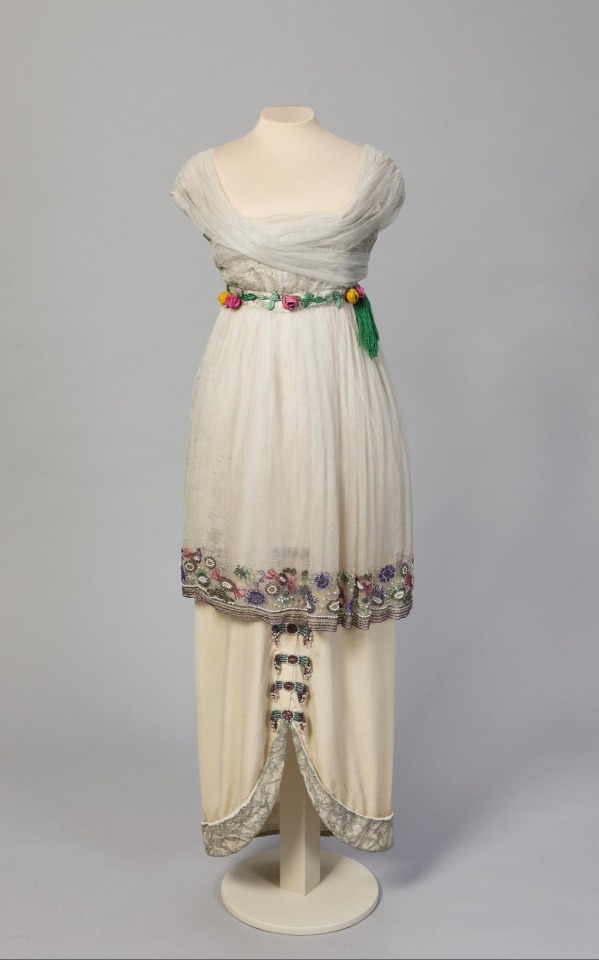
Left 1913 (June issue) La Gazette du Bon Ton, "Je Suis Perdue Robe d'été de Chéruit" tumblr.com/mote-historie/729728522325753856/pierre-brissaud-je-suis-perdue-robe-d%C3%A9t%C3%A9-de?source=share&.
Center 1913 La Mode cover art La Mode par Boué Soeurs by George Barbier. From tumblr.com/mote-historie/731263453639196672/george-barbier-la-mode-par-bou%C3%A9-soeurs-french?source=share&.
Right 1913 Les Modes Dinner Dresses by Gustave Beer. From tumblr.com/mote-historie/731172312816254976/dinner-dresses-by-beer-1913?source=share& 1975X2861

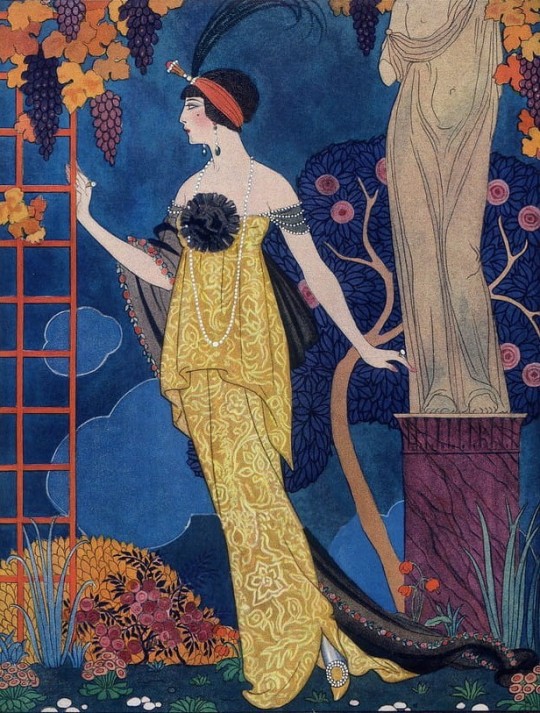
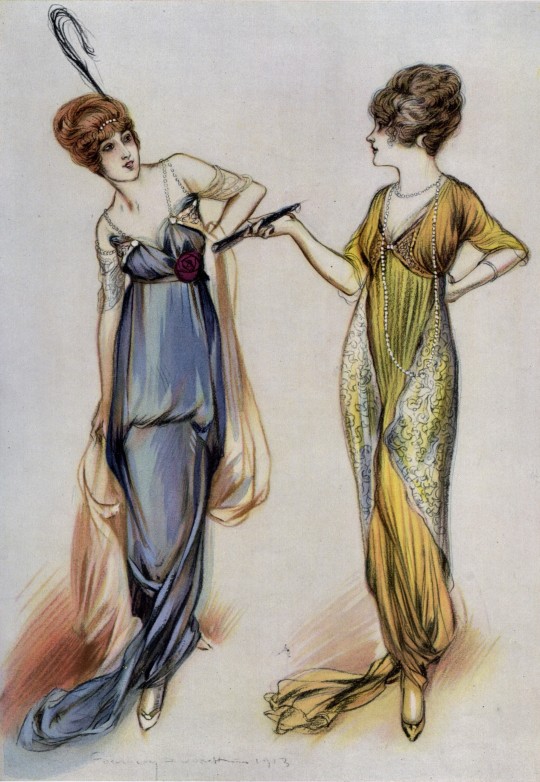
Left 1913 Tanzerin by Julie Wolfthorn (location ?). From tumblr.com/random-brushstrokes 727X1024.
Right 1913 Anastasia Mikhailovna de Torby, Philip de László (location ?). From tumblr.com/la-belle-histoire/745161897381445633/portrait-of-anastasia-mikhailovna-de-torby-philip? 608X960.

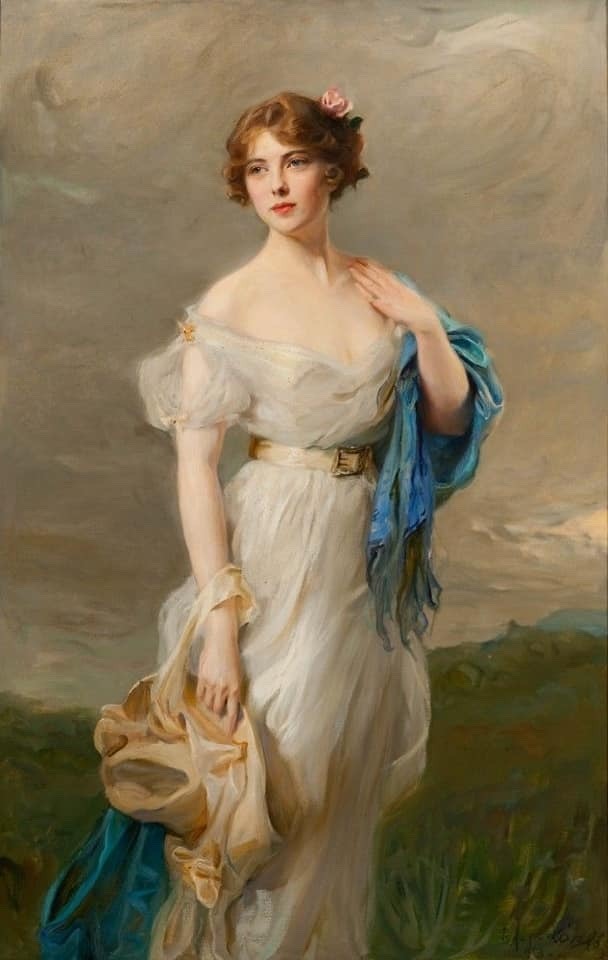
Left ca. 1913 Dame in een zwarte strompeljapon met kant by anonymous (Rijksmuseum). From their Web site; fixed flaws & spots w Pshop 3542X5395.
Right ca. 1913 Dame in een geel/groen geruite strompeljapon by anonymous (Rijksmuseum). From their Web site; fixed flaws & spots Pshop 3476X5328; fixed flaws & spots w Pshop 3645X5328

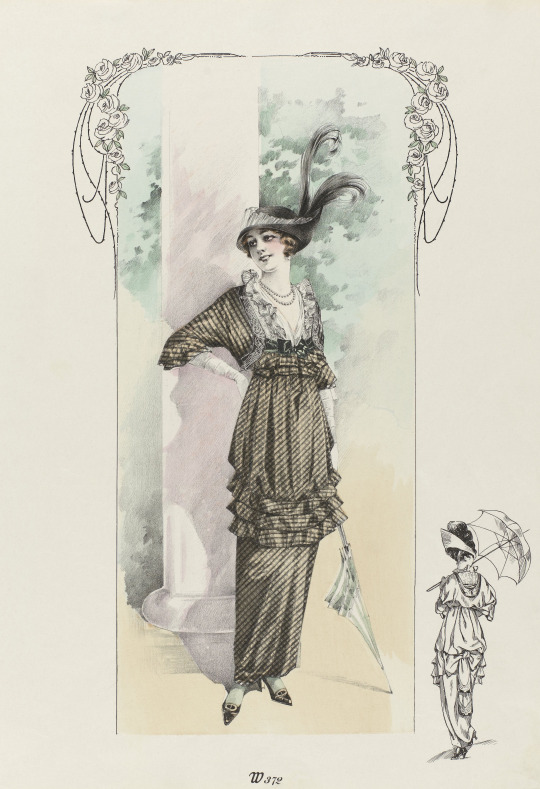
#1913 fashion#1910s fashion#Belle Époque fashion#Edwardian fashion#Ethel Mary Bell-Irving#Samuel Henry William Llewellyn#George Barbier#pochoir#Pierre Brissaud#Robert Dammy#Rosa Lewis#Frank Moss Bennett#Robert Pichenot#Jean Maillard-Norbert#Léon François Comerre#Lina Bilitis#Giovanni Boldini#Madame Michelham#María Teresa González del Valle#Nicanor Piñole#Joaquín Sorolla y Bástida#Julie Wolfthorn#Vera Karakhan#Poiret#evening dress#Chéruit#day dress#parasol#small hat#Beer
34 notes
·
View notes
Text

Alekseev Fedor (1753(¿1754?)-1824) VISTA DEL CASTILLO MIKHAILOVSKY EN SAN PETERSBURGO 1799-1800 Tamaño - 20x28 Material - papel sobre papel Técnica - acuarela Número de inventario - Inv.2818 Adquirido por P. M. Tretiakov. Antes de 1893
Ante nosotros hay un boceto de una pintura almacenada en el Museo Ruso. La acuarela representa el Castillo Mikhailovsky desde el lado del Jardín de Verano y la Fontanka, una de las vistas más hermosas de San Petersburgo. El proyecto del castillo perteneció a VI Bazhenov, la construcción fue dirigida por el arquitecto italiano V. Brenna. El artista realizó acuarelas en la tradición de los dibujos de arquitectos. El elegante diseño de plumas se destaca con tonos claros y transparentes. A petición del emperador Pablo I, el castillo se convertiría en su residencia personal. El emperador quería tener una fortaleza inexpugnable rodeada de fosos. El castillo no se completó cuando Alekseev lo pintó. El paisajista captó con sensibilidad la exquisita belleza de la ciudad, que más tarde sería conocida como la Venecia del Norte. No es casualidad que la vista representada evoque asociaciones con las obras de los paisajistas italianos. El artista pasó cuatro años en Venecia como pensionado (como se llamaba a los becarios en ese momento) de la Academia de las Artes. A su regreso a San Petersburgo, copió paisajes de maestros italianos en el Hermitage. Los contemporáneos llamaron a Alekseev "Canaletto ruso".
Información e imagen de la web de la Galería Tretyakov.
5 notes
·
View notes
Text

Juan de Pareja (atribuido)
Retrato de un Caballero de la Orden de Santiago (h. 1630)
Museo del Hermitage, San Petersburgo
2 notes
·
View notes
Text

Henri Matisse (1869-1954)
La habitación roja (Armonía en rojo), 1908
Óleo sobre tela, 180,5 x 221 cm
Museo del Hermitage, San Petesburgo
Fuente: theartlife.blogspot.com
29 notes
·
View notes
Text

"Amistad", 1908. Pablo Picasso. Óleo sobre lienzo. Museo del Hermitage, San Petersburgo, Rusia.
10 notes
·
View notes
Text

Louis-Léopold Boilly
Game of Billiards, 1807 Oil on canvas, 56 cm x 81 cm Romanticismo
Esta pintura resume la era de los cambios sociales en Francia después de la Revolución de 1789, con su afirmación de nuevos gustos y normas de comportamiento.
Durante el período del Directorio y el Primer Imperio, las salas de billar se convirtieron en una especie de clubes a los que la gente acudía no sólo para jugar, sino también para encontrarse con amigos, hacer nuevas amistades, cotillear y coquetear. Aquí se intercambiaban detalles de noticias familiares y sociales, se discutían los últimos acontecimientos políticos y sociales. El personaje principal del cuadro es una mujer que juega al billar, lo que da testimonio de las costumbres liberales de la época.
📍 Museo Hermitage, San Petersburgo (Rusia)
#painting#inspiration#paint#arte#fan art#pintura#arteveryday#art#iamainhoa#romantique#romanticism#romantic#hermitage
3 notes
·
View notes
Text
El mercado de esclavos en la antigua Roma: un capítulo oscuro en el comercio de mujeres
En la antigua Roma, la trata de esclavos era una parte integral de la economía y la estructura social. Los esclavos procedían de diversas fuentes: prisioneros de guerra, esclavitud por deudas, nacimiento o comercio, y se utilizaban en muchas áreas de la vida diaria, desde el trabajo agrícola hasta el servicio doméstico y más.
Los esclavos, tanto hombres como mujeres, eran presentados desnudos para que los posibles compradores pudieran examinar su condición física, que se consideraba un indicador de su salud y capacidad para trabajar.
Esta práctica puso de relieve la cosificación y deshumanización de los esclavos, que eran vistos como propiedad.
Las mujeres en el mercado de esclavos tuvieron momentos particularmente difíciles. Se vendían no sólo para las tareas habituales como tareas domésticas, trabajos del campo o manualidades, sino también para servicios más íntimos por su apariencia y juventud.
El mercado de esclavas incluía siempre un componente sexual; A menudo se compraba a las mujeres por su potencial como concubinas o prostitutas.
En el derecho romano, los esclavos eran tratados como "res", es decir, como cosas. No tenían derechos personales y su estatus se transmitía de generación en generación si tenían hijos.
Las mujeres nacidas en esclavitud permanecían en esa posición durante toda su vida a menos que fueran liberadas, lo cual era poco común y a menudo conllevaba condiciones.
La trata de esclavos, y en particular la venta de mujeres desnudas en los mercados, tuvo un profundo impacto social y cultural en la vida romana, se consideraba cada vez más inapropiado, (claro esta qué esto no contempló a los esclavos venidos de África, en años posteriores).
Reforzó las desigualdades sociales y de género y dio forma a la visión romana de la propiedad y el poder.
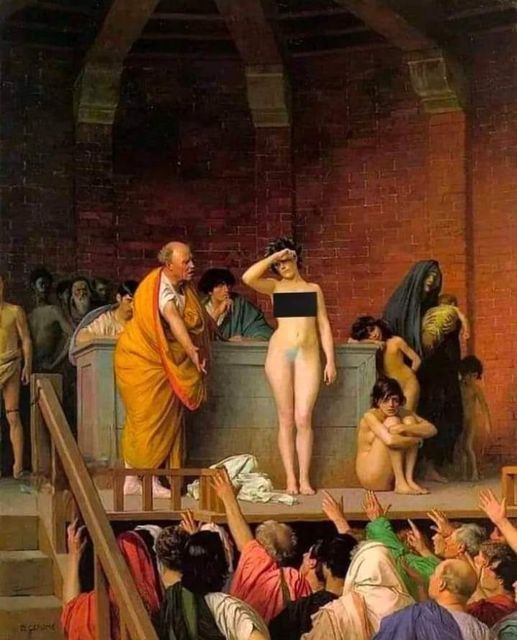
"Mercado de esclavos en la antigua Roma" y data de 1884. Fue dibujado por Jean-Leon Gerome, que vivió en Francia entre 1824 y 1904. Actualmente se encuentra en el Museo Estatal del Hermitage, en San Petersburgo, Rusia.
Augusto Dario Auden Correa / FB
hoy en día, hombres y mujeres se exhiben como cosas en las redes 🙄, Viva la libertad!!!😒
6 notes
·
View notes
Text
MUSEO IRREVERENTES: “Marie Madeleine dans la grotte ” (1876)
Jules Joseph Lefebvre (1834-1912)Óleo sobre lienzo71.5 cm x 113.5 cmMuseo del Hermitage (San Petesburgo, Rusia)

View On WordPress
3 notes
·
View notes
Text

Museo Hermitage - - San Pietroburgo
Scala "della Giordania"...
6 notes
·
View notes
Text
En su libro El jardín prohibido de Leningrado , el autor Simon Parkin cuenta la historia del Instituto de Plantas de la ciudad —el primer banco de semillas del mundo— durante el asedio nazi de 1941-1944. “Los miembros del personal del instituto se sacrificaron, uno por uno, para proteger una colección cuya única razón de ser era salvar algún día a la humanidad del hambre”, escribe el crítico Simon Ings. A pesar de las privaciones impensables, Vadim Stepanovich Lekhnovich, el conservador de la colección de tubérculos, dijo más tarde que “no era difícil no comer la colección. Era imposible comer esto, el trabajo de tu vida, el trabajo de las vidas de tus colegas”. El genetista Nikolai Vavilov trabajó para mejorar las características de las plantas y prevenir hambrunas futuras. Crédito: Pictorial Press Ltd/Alamy Publicado originalmente en Nature Por Simón Ings Traducido por María Gil para Humanidad y Medio El jardín prohibido: los botánicos de Leningrado sitiado y su elección imposible Simon Parkin Scribner (2024) Después del relato de Simon Parkin sobre el asedio de Leningrado y el destino del primer banco de semillas del mundo, después de su posdata, epílogo y agradecimientos, hay nueve páginas que, para quienes conocen la historia, valen el resto del libro en conjunto. Se trata de la lista de personal, recopilada meticulosamente a partir de registros institucionales y otras fuentes, de lo que Parkin llama simplemente el Instituto de Plantas. En aquel entonces se llamaba más exactamente Oficina de Botánica Aplicada y Fitomejoramiento, que en 1992 se convirtió en el Vsesoyuzny Institut Rastenievodstva en San Petersburgo, Rusia. El instituto fue fundado en el siglo XIX por el horticultor y botánico alemán Eduard August von Regel y fue ampliado enormemente por el agrónomo soviético ruso Nikolai Vavilov. La lista no es de fácil lectura. Hambre, hambre, hambre, muertos en el frente… Entre el 8 de septiembre de 1941 y el 27 de enero de 1944, mientras las fuerzas alemanas asediaban la ciudad, los colaboradores del instituto se sacrificaron, uno a uno, para proteger una colección cuya razón de ser era salvar un día a la humanidad del hambre. Soldados alemanes en las afueras de Leningrado, sitiada en 1941. Crédito: IanDagnall Computing/Alamy Mientras que, a la vuelta de la esquina, los dos millones de objetos del museo de arte del Hermitage de Leningrado se guardaban en un lugar seguro, el Instituto de Plantas se enfrentaba a problemas de otra magnitud. Sus 2.500 especies (que comprendían cientos de miles de semillas, rizomas y tubérculos) estaban vivas y era necesario mantenerlas a una temperatura de uno o dos grados por encima del punto de congelación. Muchas de ellas, unos 380.000 ejemplares de patatas, centeno y otros cultivos, sobrevivirían sólo si se plantaban anualmente. Esto en una ciudad que sufría bombardeos de hasta 18 horas al día y donde la temperatura podía (y, en febrero de 1942, lo hizo) caer a unos -40 °C. Johan Eichfeld, el director del instituto tras la desaparición de Vavilov (su arresto y encarcelamiento secreto, en realidad), fue evacuado a la ciudad de Krasnoufimsk, en los Urales. Un tren con gran parte de la colección debía seguirlo, pero nunca llegó. Eichfeld finalmente se puso en contacto con el instituto y rogó a su personal que se comiera la colección para salvarse. Pero ya habían perdido la colección por hambre una vez antes, durante el terrible invierno de 1921-22. No iban a volver a hacerlo. Enero y febrero de 1942 fueron los peores meses. En el oscuro y gélido edificio del instituto, los trabajadores preparaban semillas para su conservación. Dividieron la colección en partes duplicadas, mientras las bombas estallaban a su alrededor. Los alemanes nunca lograron invadir Leningrado, pero las ratas sí. Ese primer invierno, hordas de alimañas invadieron el edificio. Ningún esfuerzo por proteger la colección resultó a prueba de ratas: incluso lograron abrir cajas metálicas ventiladas para devorar las s...

View On WordPress
0 notes